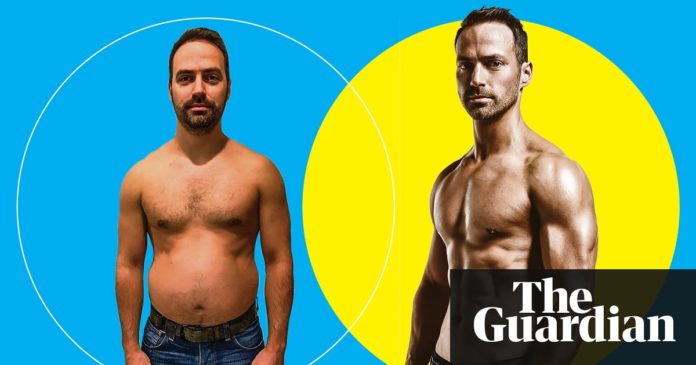Mens Health magazine has transformed many men and its own fortunes by featuring extreme muscle makeovers. But does changing shape fast have a dark side?

In 2004, Mens Health journalist Dan Rookwood walked into his editors office in a funk. The topless beefcakes who appeared on their covers were unrealistic, he had decided. No one actually looked like that not least the staff of what was then the UKs third-biggest-selling mens magazine. His editor smiled. He felt a feature coming on.
Just over a year later, a smirking Rookwood appeared on the March 2006 cover of Mens Health. His biceps were huge, his six-pack extraordinarily well defined. From fat to flat! read the cover line, alongside a picture of a mournful-looking Rookwood, pre-transformation, his belly soft and rounded. It became the biggest-selling Mens Health issue of all time.
The transformation genre of mens magazine cover stories was born. Since then, they have become the bread and butter (or steamed spinach and chicken breast) of these publications. Pick up a copy of Mens Health every six months or so and you will see a topless staffer grinning for the camera, next to the words Get shredded in six weeks! or From scrawny to brawny!
In difficult times for print publishing, Mens Health and its competitors hit upon a monetisable formula. Across the country, podgy dads and harried office workers dreamed of having the perfect physique. Makeover transformations promised the body they longed for typically within eight to 12 weeks.
A cottage industry whirred into action. You can join the Mens Health Transform Club or purchase a copy of the Mens Fitness 12 Week Body Plan. The message is clear: ditch the carbs, start deadlifting and you too can upgrade your dad bod to the crisply defined torso of a Hollywood hunk.

But getting shredded takes serious graft. Its quite a drastic lifestyle change, says former Mens Health journalist (and January 2017 cover star) Tom Ward. The hardest part was giving up his favourite sugary foods. Ive got a real sweet tooth and I eat ice-cream all the time, so towards the end I was Googling videos of people making cakes and dreaming of what Id eat.
Its 80% about nutrition, agrees his former colleague Mark Sansom, who ended the challenge with 48cm (19in) biceps. Eating four portions of microwaved fish a day took its toll. Youd be forcing it down. It wasnt enjoyable. Avoiding alcohol the nemesis of defined torsos everywhere was difficult, too. You realise how much British life is arranged around booze, says Jon Lipsey, the Mens Fitness cover star for May 2018.
I wanted to prove to the readers that the cover lines we preach at Mens Health are possible, Sansom says. Were normal guys. But how normal? All were given personal trainers and Wards editor allowed him time off work to train.
Cover model transformations are not snake oil they do work, provided you are a staff journalist at a magazine with access to high-end trainers, a sympathetic boss and the time to spend hours meal-prepping protein-based meals.
While the Mens Health cover body may be attainable, most people are not able to maintain the necessary lifestyle once the challenge is over. For me, the diet was not sustainable long term, whereas the training has been, says Rookwood. He is conflicted about his role in creating the genre of cover transformation stories. It was just a bit of fun, Rookwood says. Something to tell the grandkids;, maybe frame in the downstairs loo someday.
The Mens Health team did more than shift magazines: they ushered in a protein-blasted physical aesthetic. In this new paradigm of masculine excellence, anyone can achieve physical perfection if they put in the hours. It is an aspirational narrative, accompanied by a specific vernacular. Men are hench, wammo or tonk. A good swolder never forgets leg day.

Our physical ideals change according to the times in which we live. The 80s masculine ideal was typified by action heros such as Arnold Schwarzenegger and Sylvester Stallone, while scrawny, beer-drinking lads dominated the 90s. The idealised body image is highly muscular right now, says Dr Stuart Murray, a psychologist who specialises in muscle dysmorphia in men. What distinguishes this ideal from that of the 80s is a preoccupation with maintaining a single-digit body-fat percentage to better display ones muscularity.
Whereas the vest-wearing action stars of the 80s needed physical strength to hoik themselves into lift shafts and avert terrorism, todays uber-tonk males wear their six-packs like beautiful, pointless feathers: this is a cosmetic muscularity, rather than a functional one. Its most prominent brand ambassadors are, of course, the preening and tensing men of Love Island, who are effectively one giant regional gym made flesh.
The emergence of this physical ideal is linked to the death of lad culture. Magazines are reflectors of society, says Simon Das, a lecturer in journalism at London College of Communication. Magazines such as Nuts and Zoo were out of kilter with the new generation of men coming through. As the lads mags were counted out, health-focused publications absorbed their readerships, with Mens Health overtaking FHMs sales in 2009. Mens Health remains the biggest paid-for magazine in the mens lifestyle sector, with a circulation of 175,683 at the end of 2017.
Mens magazines reflect and reinforce the cultural zeitgeist. Young men today are interested in wellbeing and fitness and looking good, Das says. So this is reflected in the editorial interests of magazines oriented at guys.
Mens magazines alone did not give rise to this new ideal; there were other factors. Gymgoing became democratised, with chains such as PureGym (which opened in 2009) and Fitness4Less (founded in 2010) bringing affordable membership to the masses. The pursuit of fitness accrued social capital, with streaming sites such as YouTube making celebrities of personal trainer Joe Wicks and fitness gurus The Hodgetwins. Some argue that the financial crisis created the gym bro: as traditional routes to success were eroded, men fell back on their bodies as a means of feeling valuable to society. Concurrently, young people stopped drinking as much.
You may think: what is the harm in counting reps on a chest press? But the masculine frame we fetishise today can be as pernicious as the uber-thin supermodels we typically condemn for perpetuating unrealistic body ideals.

Aziz Sikdar, 29, became unhappy with his body after gaining weight at university. He turned to YouTube channels including Athlean-X and Yo Elliott, as well as Mens Health and Mens Fitness. Id look at YouTube channels and magazines so much that bodies of that type seemed the norm to me and I felt like I was lacking.
Sikdar tried a few cover-story plans. Generally, they werent very effective. While their diet tips were helpful, I didnt get much from the workouts themselves, he says. Theyd recommend something one month and then, a couple of months later, tell you the complete opposite.
Rapidly, Sikdar developed an unhealthy relationship with food. I always had to know the breakdown of what I was eating, he says. Id binge a lot, completely overeat, then starve myself out of guilt. Once, he ate at McDonalds eight times in a five-day period.
Because nutrition is essential to achieving the cosmetic muscularity that is in vogue, those predisposed to disordered eating can adopt worrying behaviours. Diet is imperative to get the sort of results these men are working towards, says Sam Thomas of the charity Men Get Eating Disorders Too. That can become a focus in itself and spiral. Even men who appear in prime health can be in the grip of a devastating illness linked to their desire to achieve a more muscular goal.
As eating disorder services tend to be designed for women, male sufferers can be overlooked. Only one in 10 patients who seek help for eating disorders are men, despite the fact that men are as likely as women to suffer. Clinicians are trained to look for emaciation, despite the fact that many sufferers are not underweight, particularly if they are packing on muscle at the gym. Another complication is that these guys are coming from gyms where there is a no pain, no gain ethos, which means theyre socialised into thinking its OK to forgo important parts of their lives in the service of this muscularity, says Murray. They dont see it as a problem.
My mental state became a complete mess, says Sikdar. The gym and my body seemed to be one place I had some control and was succeeding.
Murray says that men work out to elevate their standing among other men, not women. A compliment from a man is worth more than a compliment from a woman, because males have more credibility in affirming other males.
After a month spent learning muay thai in Thailand, Tom Usher, 30, felt himself change. I wasnt scared of anyone, he muses. When you look chung physically, you feel chung and that confidence translates into how you act around women, but also men. It plays to some kind of physical superiority thing that men like to have over other men, regardless of whether they know about it consciously or not.
Although Murray does not believe the media causes eating disorders, he says it creates the powerful social comparisons that Usher and Sikdar experienced. Exposure to these images gives positive connotations of what it means to be highly muscular for males, he says. This almost always induces a profound body dissatisfaction that results in compensatory efforts to try and increase ones muscularity. Individuals can end up in a dangerous cycle of overexercising and restricted eating.

Why is it that we condemn womens magazines for including weight-loss tips, but mens magazines escape our censure? Both say: you are not OK as you are. You should change. Both perpetuate body ideals that, despite what they may claim, are not practicably achievable by everyone.
Theres no set manual that every man can use to get the same results, says Thomas. Not every man can get the desired result within six weeks. You can do the same workout as other men and you wont get the same result. Some may feel cheated and go to extreme lengths to get the result they were promised. These measures can be harmless: protein bars or creatine shakes. But not always.
As it is very difficult to have an abnormally pumped, low-body-fat physique without chemical help, experts link todays cosmetic muscularity to substance abuse.
I was definitely tempted by steroids, says Sikdar. He is not alone. Steroid abuse is on the rise, with an estimated 1 million users in the UK. In 2015, reality star Spencer Matthews admitted to a secret steroid addiction fuelled by vanity. Matthews is one of the lucky ones: many do not survive steroid addiction. Dean Wharmby, a bodybuilder from Rochdale, died of liver cancer induced by his misuse of anabolic steroids in 2015. Cult Australian bodybuilder Aziz Shavershian, known as Zyzz, was the poster boy for a muscularity-oriented lifestyle, posting his workouts online to thousands of followers. In 2011, he died in a sauna in Thailand at the age of 22. After his death, it emerged that Shavershian had been taking clenbuterol, which can induce cardiac arrhythmia.
What makes men die pursuing a cosmetic goal? Being big was what everyone knew Dean for, Wharmbys partner Charlotte Rigby said after his death.
Murray says: You generate this wonderful physique and get lots of compliments and then the fear of not maintaining this physique becomes powerful. It becomes your primary identity. That leads to some of the extreme lengths these guys go to.
Of course, not everyone who tries to get shredded becomes unhealthy. Most will get in shape for a while, then slip back. Gym memberships go unused. Magazine subscriptions expire. Perhaps it will not all be for nothing: they will eat more healthily or exercise more often.
After his cover shoot, Ward went on holiday with his girlfriend. It was nice being on the beach and not feeling self-conscious about his body. But life got in the way of training. He is unaffected by the loss of his former physique. I feel good about myself sitting on the beach now with my dog, even if Im a bit fat.
Sansom has put on a fair bit of weight since his cover shoot. Like Ward, he is relaxed about it. Browsing WH Smith recently, Sansom was confronted by his former glory: Mens Health had reused his body on the cover of a transformation manual. I looked down and thought: Ive kind of let myself go, he laughs. But Im only two or three months away from getting back into good nick.
Read more here: http://www.theguardian.com/us





